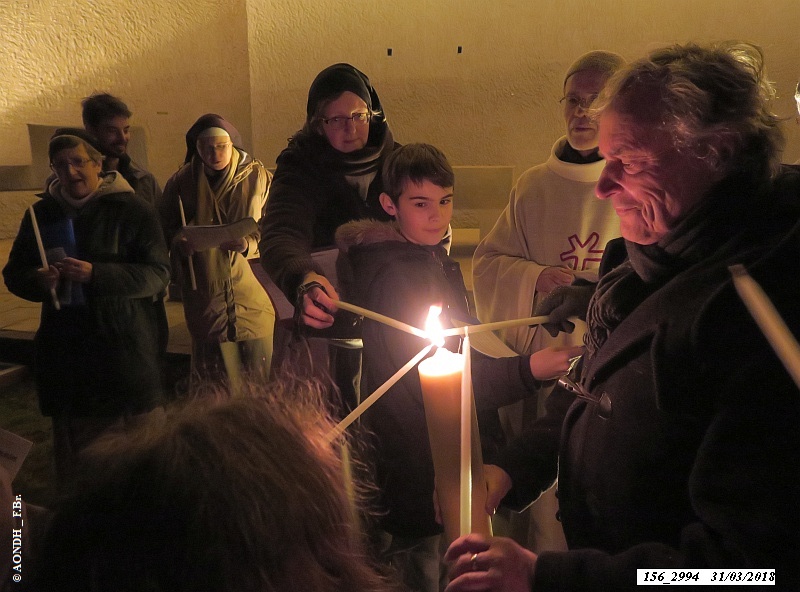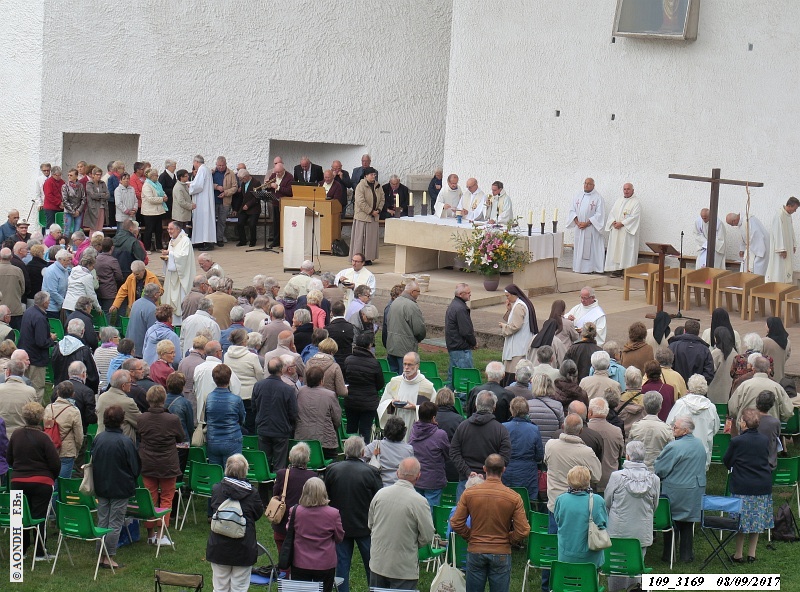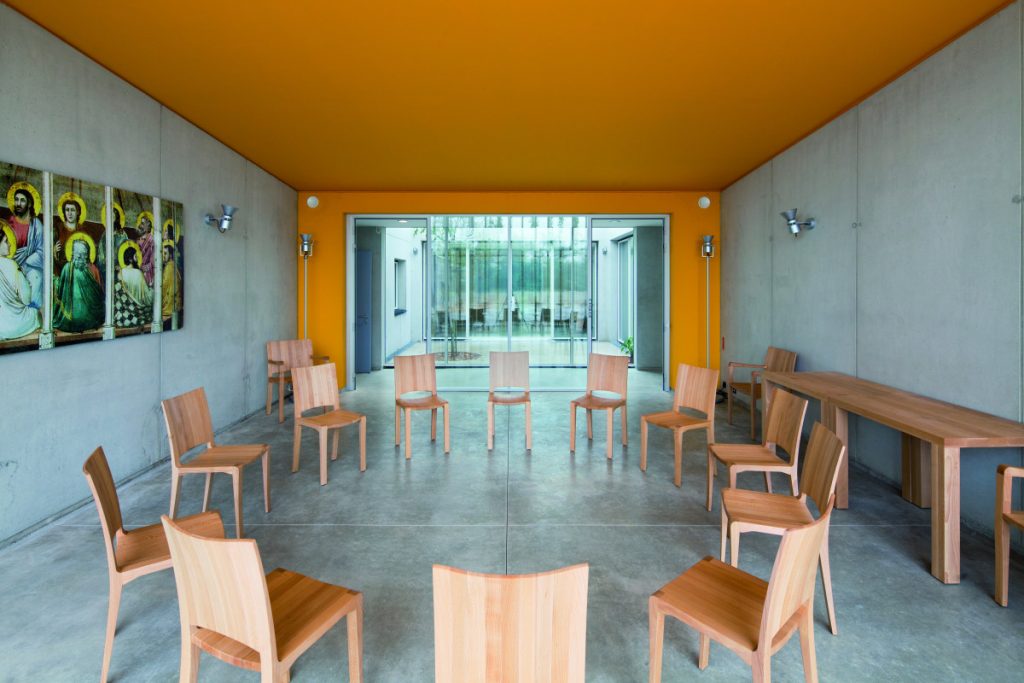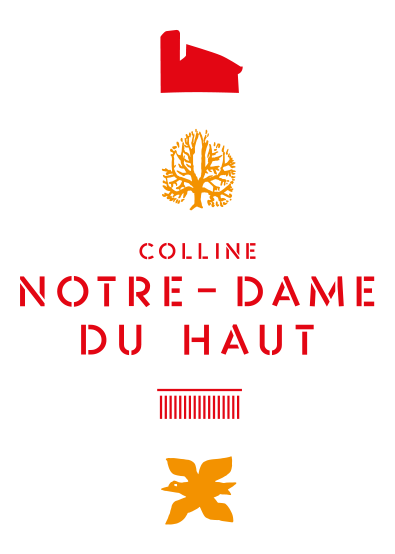- Discovering the Hill
- No content found
- Plan your visit
- No content found
- Agenda
- 2022-2024 : Renovation of the chapel
- Shop
Any Chapel has a Chaplain. This title is used for the priest designated by his hierarchy to work for the Chapel.
Up to 1958, this charge was devoted to a priest of Ronchamp parish. Then, Father Bolle-Reddat was in charge of the Chapel until 2000. Different priests or clerics succeeded him, notably Father Louis Mauvais, Brother Patrice Kervyn, a Franciscan, then Father Frederic Dumas.
A common road map was given them with the following elements:
For all these tasks, the Chaplain is helped by a team of laypersons called “Pastoral Committee”, with whom he defines the different tasks to be completed, he prepares the church services, he makes sure the cult is properly carried-out in the Chapel.
Yet, beyond these roles, the Chaplain works as a watchman. Among the different teams, he never stops reminding of the Catholic religious identity of the place, a sanctuary dedicated to the Virgin Mary, for whom Le Corbusier built this Chapel, as a place of silence, inner peace, and joy.
With the monastery and in the Association AONDH, he aims at developing the spiritual activity of the sanctuary by appropriate propositions, under the Rector’s supervision.

No archaeological remains and no written document gives any information on the history of the hill of Bourlémont before the middle of the Middle Ages. What was there before that?
19th -century chroniclers imagined a Roman temple at the top of the hill, even if it remains doubtful.
In 595, Colomban, a saint who had come from Ireland to evangelize the region, settled in Luxeuil, nearby Ronchamp. This abbot or one of his disciples might have founded Notre-Dame du Haut.
In 1092, a legal document mentioned for the first time a church dedicated to the Virgin Mary on the hill. It was the parochial church of Ronchamp and the villages around.
It is the place where the parish life took place until 1743, when Notre-Dame du Bas was founded, in the village-center. Notre-Dame du Haut might have been situated at the top of the hill for purely symbolical reasons: as the most sacred place of the community, the church was placed at the top, between Heaven and Earth.
The pilgrimage of the 8th September (Nativity of the Virgin Mary) was attested as early as the 15th century. Some time later, an inhabitant from La Côte said that he had been released from prison thanks to the intercession of the Virgin Mary, who was then called Our-Lady of Liberation.
The Virgin of Ronchamp has been helpful to everyone ever since.
Another pilgrimage became popular in the 19th century, on the 15th August (Assumption of the Virgin Mary).
These two celebrations are still at the heart of the religious activity of the site.


St-Clare’s nuns (“Poor Clare sisters”) belong to a contemplative order which was founded by St-Clare of Assisi in 1212. Their monasteries generally settle in towns or next to them.
As disciples of St Francis of Assisi, they lead a frugal life, composed of prayer, work and reception which makes them available for listening to others. Their way of life is in tune with the hill.
The Chapel is steeped in their daily prayer, and they offer a spiritual welcome to pilgrims and to all those who wish to find a place where they can feel rejuvenated.
« Rooted in the earth to receive the light from above” (Renzo Piano), the monastery where the sisters are permanently present is open to every person wishing to go a little deeper inside themselves, to entrust themselves to the prayer of the community, to find someone who listens to them, who gives them a spiritual support.
A stay for one person or for a small group (11 persons maximum) gives guests the opportunity to experience silence, to taste the spirit of the place, to contemplate nature, to engage in private prayer at the oratory or in the Chapel Notre-Dame du Haut, to take part in the community prayer, to experience a regenerative solitude in order to choose their lives.
The liturgical key moments such as Advent and Christmas, Lent, the Holy Week and Easter, Easter time or diverse Marian celebrations are good moments for a retreat and more intense prayer.

13 rue de la Chapelle
F-70250 Ronchamp
+33 (0)3 84 20 65 13
Contact
15 April to 13 October 2024: 10am to 6pm
From 14 October 2024: 10am to 5pm
Last admission: 30 minutes before closing time. Closed on 25 December and 1 January
For journalists
Connect
Educational resources
To go further
+33 (0)3 84 20 73 26
Contact
Réalisation DN Consultants